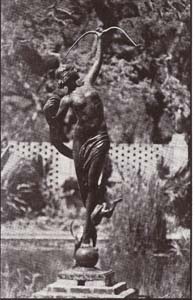Anna Hyatt was born at Cambridge, Massaachusetts on March 10th, 1876. She was already an acclaimed sculptor when she married Archer Milton Vaughn Huntington in 1923. Together they shared an enthusiasm for Spain, wildlife and sculpture.

Animal sculpture was Huntington's special field throughout her career and consistently won her awards in exhibitions, with the equestrian statue being one of her primary choices.
An equestrian statue of Joan of Arc, for which the sculptor was decorated with the purple rosette by the French government, was erected on Riverside Drive, New York, in 1915; the model was awarded honorable mention at the Paris Salon in 1910.
Her equestrian statue of the Cid Campeador was presented to the city of Seville in 1927, and replicas were erected on the grounds of the Hispanic Society of America, N ew York, as well as in several other cities. More works were added to the Hispanic Society's terraces, including animals in bronze and marble and two large reliefs of Don Quixote and Boabdil on horseback. In 1929, the Academia de Bellas de San Fernando at Madrid elected her a corresponding member, an -honor not previously given to a woman.
She was awarded the gold medal for distinction in sculpture by The American Academy of Arts and Letters, which organized a retrospective of her work in 1936, and a special medal of honor from the National Sculpture Society in recognition of her achievements as a sculptor and in appreciation of her unfailing interest in her fellow sculptors. Syracuse University and The University of South Caroloina gave her honorary degrees. Her name is included among the fourteen most prominent women of 1960 by the Who's Who of American Women.
BROOKGREEN GARDENS: The original plan involved a tract of land from the Waccamaw River to the ocean in Georgetown County, South Carolina, for the preservation of the flora and fauna of the southeast. At first the garden was intended to contain the sculpture of Anna Hyatt Huntington. Together with her husband, Archer Milton Huntington, they created one of the finest public sculpture gardens in America, Brookgreen Gardens.
Begun in 1931 on the grounds of a 200-year old rice plantation with a small number of artworks from their personal collection, it has grown into the world's largest permanent collection of American figurative sculpture. Currently the collection numbers over 450 works by 208 sculptors and continues to expand in scope and quality. The list of sculptors reads like a Who's Who of American Sculpture: Gutzon Borglum, Frederic Remington, Augustus Saint-Gaudens, Malvina Hoffman, Paul Manship, Gaston Lachaise and Allan Houser to name a few. (Several of these sculptors will be featured in future articles.)
In 1989, while traveling to Florida to attend some art shows, I had the great pleasure of discovering the treasure of Brookgreen Gardens. It was shortly after hurricane Hugo had demolished the area. I had witnessed massive destruction--houses roofs blown off, numerous trees uprooted, and yet strangely, not a single sculpture was damaged at the gardens. If you ever get a chance to visit South Carolina, don't miss the joy of this wonderful place. When you arrive you will be greeted by this telling inscription carved into a stone at the entrance.
Inscription for a Garden Gate
Pause, friend, and read before you enter here
This vine-clad wall encloses holy ground
Herein a mellowed garden dreams away the years
Steeped in serene, sweet light and muted sound
Herein tranquillity and peace abide
For God walks here at cool of evening-tide
Pause, friend, and strip from our your heart
All vanity, all bitterness, all hate
Quench, for this hour, the fever of your fears
Then, treading softly, pass within this gate
There, where the ancient trees await, hushed and dim
May you find God, and walk awhile with Him.
- Pearl Council Hyatt

